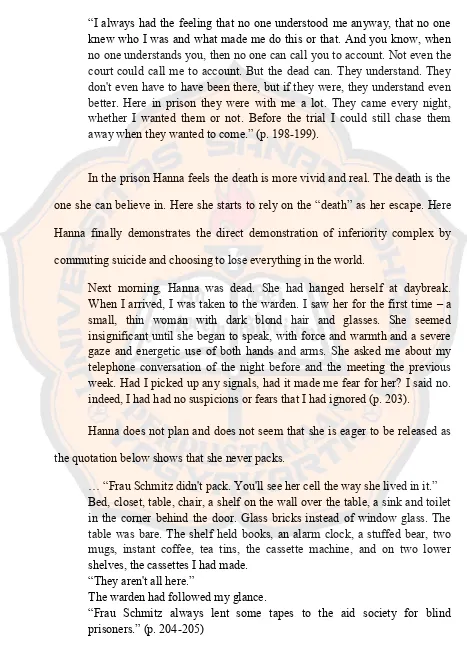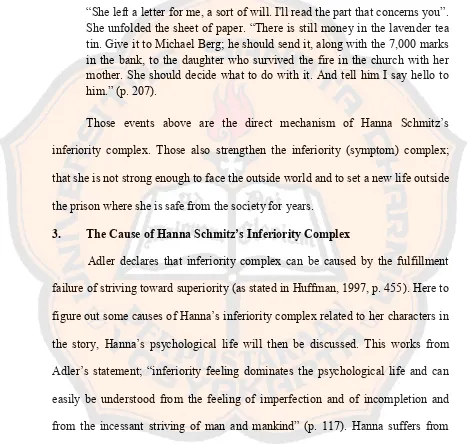Informasi Dokumen
- Penulis:
- Epiphana Ratri
- Pengajar:
- Henny Herawati, S.Pd., M.Hum.
- Sekolah: Sanata Dharma University
- Mata Pelajaran: English Language Education
- Topik: The Inferiority Complex of Hanna Schmitz as Portrayed in Bernhard Schlink's The Reader
- Tipe: thesis
- Tahun: 2012
- Kota: Yogyakarta
Ringkasan Dokumen
I. Introduction
This section introduces the topic of inferiority complex as experienced by Hanna Schmitz in Bernhard Schlink's novel, The Reader. It outlines the significance of understanding character traits and psychological issues in literature, particularly how they relate to educational objectives. The introduction serves to establish the relevance of exploring psychological themes in literary works to enhance critical thinking and empathy among students.
II. Review of Related Literature
This section reviews the theories that underpin the analysis of Hanna Schmitz's character. It discusses the psychological approach to literature, emphasizing the importance of understanding character development and traits. Theories of personality, inferiority complex, and existential psychology are explored to provide a theoretical framework for analyzing the character's motivations and behaviors, which can inform pedagogical strategies in literature education.
2.1 Theory of Literature
This subsection focuses on the psychological approach to literature, explaining how it helps in understanding the motives underlying human behavior in literary characters. This approach is crucial for students to analyze and interpret texts critically, fostering deeper engagement with literature.
2.2 Theory of Psychology
This subsection delves into the psychological theories relevant to understanding Hanna's character, including personality theories and the inferiority complex. It highlights how these theories can be applied in educational settings to help students connect psychological concepts with literary analysis.
III. Methodology
This section outlines the research methods employed in the study, including library research and a psychological approach to literature. It emphasizes the importance of using diverse sources, including primary and secondary literature, to support the analysis. This methodological rigor is essential for students to learn how to conduct thorough literary research and analysis.
IV. Analysis
The analysis section provides a detailed examination of Hanna Schmitz's character traits and her inferiority complex. It discusses how her illiteracy and perceived social inadequacies shape her behavior and decisions. This analysis is vital for students to understand character development and the impact of psychological issues on narrative structures.
4.1 Character Traits of Hanna Schmitz
This subsection explores Hanna's physical appearance, social traits, and personality characteristics. It emphasizes the significance of character traits in understanding the motivations behind actions, which can enhance students' analytical skills in literary studies.
4.2 Inferiority Complex
This subsection describes the nature of Hanna's inferiority complex, including its causes and manifestations. Understanding this complex is crucial for students to grasp how psychological themes can drive character actions and plot developments in literature.
V. Conclusions and Suggestions
In this final section, the conclusions drawn from the analysis are summarized, highlighting the key findings regarding Hanna Schmitz's character and inferiority complex. Suggestions for future research and practical applications in educational settings are also provided, emphasizing the importance of integrating psychological insights into literature education to foster a more comprehensive understanding of texts.
5.1 Suggestions for Future Researchers
This subsection recommends areas for further exploration, such as the sociocultural aspects of the novel. It encourages students and researchers to consider broader contexts when analyzing literary works.
5.2 Implementation in Learning Activities
This subsection suggests practical activities for incorporating The Reader into classroom discussions, focusing on the psychological themes presented. Engaging students with these themes can enhance their critical thinking and empathy, aligning with educational objectives.
Referensi Dokumen
- The Reader ( Bernhard Schlink )
- The Old Man and the Sea ( Ernest Hemingway )
- The Odyssey ( Homer )
- Emilia Galotti ( Lessing )
- Intrigues and Love ( Schiller )

